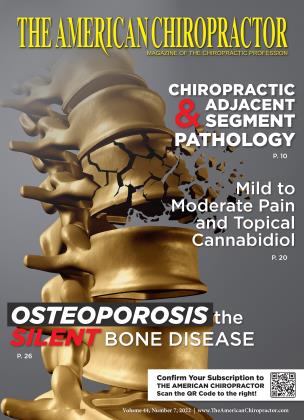Chiropractic Management of Adjacent Segment Pathology
July 1 2022 William OwensChiropractic Management of Adjacent Segment Pathology
July 1 2022 William OwensManaging spine pain and its associated symptoms can be a clinical challenge, particularly in this age of reduced resources and procedurally driven care. Research has been consistent regarding the benefits of conservative treatment in nonspecific spine-pain patients. In a very recent paper by Chu et al. (2022), the authors looked at a specific case of symptoms related to postsurgical adjacent-level spinal degeneration after cervical spine surgery.
The paper states, “Adjacent segment pathology (ASP) refers to degenerative changes observed at functional spinal units adjacent to the site of previous fusion procedure. All spinal surgeries altering motion across a joint can contribute to additional stress and mechanical loads on the segments immediately above and below the surgery site and accelerate subsequent degeneration. These conditions can compress nerves in the spine, causing pain and additional conditions like radiculopathy and myelopathy.” (p. 787) This paper importantly points out the symptoms that can develop after surgery and how they can be related to biomechanical alterations adjacent to the fusion site.
The authors continued by reporting, “The accelerated degeneration of the adjacent segments could be a multisegmental problem and can be challenging to manage. This article will enhance readers’ understanding of ASP and help primary practitioners to manage ASP effectively.” (p. 787)
This paper relates to a specific case of a patient who developed symptoms long after a cervical fusion. It reports, “Two months prior to presentation, the patient experienced rapid deterioration of her neck pain, which was associated with numbness, radiating pain, and weakness of the right arm.” (p. 788) The authors continued, after a biomechanical analysis and chiropractic care, “Six weeks later, the patient reported reduced radicular symptoms and regained motor strength (5/5) of the right biceps and wrist extensors.” (p. 788)
In the long term, the paper reported, “At 11-month follow up, radiograph showed that the cervical sagittal alignment was improved in terms of forward shifting of the gravity line and C-2 plumb line, relative to the C7 [vertebrae].” (p. 788) This is important since there is an underlying biomechanical component in most cases of spinal pain and neurologic symptoms. In this case, addressing the biomechanical pathology had a significant effect on the patient’s symptoms, even after having surgery in the past.
This paper concluded, “Presented is a case of symptomatic ASP after anterior cervical discectomy and spinal fusion. Appropriate conditioning and proper retrieval of biomechanical elasticity can allow the spine to function properly. Conservative treatments should always be contemplated as an alternative method for ASP patients before resorting to surgery.” (p. 789) Working with a spine management physician who is educated in the assessment of biomechanical alterations in the spine and its correlation to spine pain symptoms is a critical part of managing patients both in the short and long term. Biomechanical assessment and correction have the potential of reducing the frequency of unnecessary escalation in care to narcotics and/or second surgeries.
Dr. William Owens Jr is currently in private practice in Buffalo, NY. His practice employees 4 Doctors in Chiropractic and 2 Doctors of Physical Therapy. He is President and CEO of the National Spine Management Group, LLC and Clinical Director of the Fellowship in Spinal Biomechanics and Trauma. Additionally, Dr. Owens is Adjunct Faculty in Family Medicine at the State University of New York at Buffalo Jacobs School of Medicine and Cleveland University Kansas City, College of Chiropractic. He can be reached at 716.228.3847.
Reference
1. Chu, E. C., & Lee, L. Y. (2022). Adjacent segment pathology of the cervical spine: A case report. Journal of Family Medicine and Primary Care. 11(2). 787.
 View Full Issue
View Full Issue






